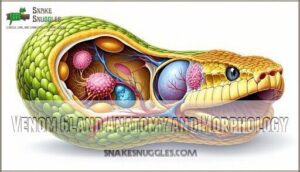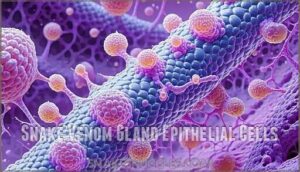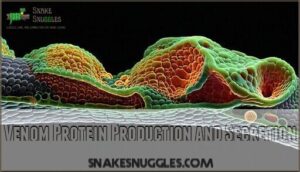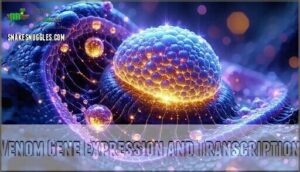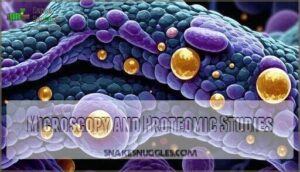This site is supported by our readers. We may earn a commission, at no cost to you, if you purchase through links.

The glands feature distinct compartments where venom components are synthesized, concentrated, and kept stable until needed. Mitochondria-rich cells maintain the low pH that prevents premature protein degradation while protecting the snake from its own lethal cocktail.
The intricate cellular machinery includes stress response mechanisms that handle the intense protein production demands. What’s fascinating is how these biological weapons evolved from simple salivary glands into precision-engineered delivery systems that can selectively target specific physiological processes in prey, making them a remarkable example of biological adaptation and evolutionary engineering.
Table Of Contents
- Key Takeaways
- Venom Gland Structure and Function
- Venom Production and Regulation
- Venom Storage and Acidification
- Development and Evolution of Venom Apparatus
- Venom Composition and Variability
- Frequently Asked Questions (FAQs)
- What is the function of the venom gland in a snake?
- What is the structure of the poison gland in a snake?
- What is the accessory gland of a venom?
- Are venom glands salivary glands?
- What is the anatomy of a venom gland?
- What is the structure of snake venom?
- How does diet affect venom gland adaptation?
- What are the genetic markers for venom potency?
- Can lifestyle changes impact venom gland health?
- How does climate influence venom gland efficiency?
- Conclusion
Key Takeaways
- You’ll find that snake venom glands are sophisticated biological factories with specialized epithelial cells that produce and store toxic proteins in acidic environments, protecting the snake from its own deadly cocktail through precise pH regulation.
- Your understanding of venom production reveals that over 2,500 genes activate within 24 hours after venom depletion, transforming cells into protein-manufacturing powerhouses that rebuild the lethal arsenal through coordinated stress response mechanisms.
- You’ll discover that venom composition isn’t static—it changes dramatically throughout a snake’s lifetime, between sexes, and across different gland compartments, with juveniles producing different toxin cocktails than adults based on their shifting dietary needs.
- You can see how these glands evolved from simple salivary glands through millions of years of refinement, with genes like Sonic Hedgehog orchestrating fang development while specialized cellular machinery creates nature’s most efficient predatory delivery system.
Venom Gland Structure and Function
You’ll discover that snake venom glands represent one of nature’s most sophisticated biological factories, engineered through millions of years of evolution to produce deadly cocktails with surgical precision.
Nature’s deadliest chemistry labs, hidden behind a snake’s eyes, brewing liquid death with molecular precision.
These modified salivary glands house specialized cellular machinery that transforms simple proteins into complex toxins capable of immobilizing prey in seconds, showcasing the surgical precision of these biological systems.
Venom Gland Anatomy and Morphology
Like a precision-engineered factory, your snake venom gland showcases remarkable venom gland anatomy through its sophisticated design.
These modified parotid salivary glands sit strategically behind the eyes, encased within a protective fibrous capsule. Venom gland morphology reveals intricate tissue organization through gland development stages that shape functionality.
Key anatomical features include:
- Glandular cell types including secretory, mitochondria-rich, horizontal, and myoepithelial cells
- Venom storage lumen within the main gland’s basal compartments and ductules
- Duvernoy’s gland in rear-fanged species, homologous yet functionally distinct
- Four-region complex: main gland, primary duct, accessory gland, and secondary duct
Snake Venom Gland Epithelial Cells
Snake venom gland epithelial cells are the powerhouse workers behind toxin production.
These secretory cell types line the gland’s interior, transforming from cuboidal to tall columnar shapes during active venom synthesis.
You’ll find their rough endoplasmic reticulum expanding dramatically as toxin synthesis location shifts into high gear.
The UPR pathway manages cellular stress while exocytosis mechanisms release completed venom proteins into storage lumens.
Researchers have even created functional venom glands in the lab using stem cells, which is a significant breakthrough in understanding venom synthesis and the potential for lab-created venom.
Cellular Stress Response Mechanisms
You’ll find venom gland epithelial cells face intense cellular stress response challenges during high toxin output periods.
UPR Pathway activation manages protein folding demands when ER stress peaks from massive toxin production.
Snake venom gland cells employ sophisticated mechanisms including autophagy and oxidative stress management to maintain gland homeostasis.
These cellular stress response systems guarantee venom gland structure and venom gland function remain superb despite overwhelming protein synthesis requirements.
Regulation of Venom Gene Transcription
Delving deeper into venom gland gene regulation reveals how transcription factors orchestrate toxin expression like molecular conductors.
Environmental factors and upregulation triggers activate complex pathways controlling venom diversity through precise gene silencing mechanisms.
- Transcription factors bind specific DNA sequences to activate or suppress venom genes
- Environmental factors like temperature and prey availability influence toxin expression patterns
- Gene silencing mechanisms prevent unwanted venom production during rest periods
- Upregulation triggers following venom depletion activate over 2,500 genes within 24 hours
- Venom diversity emerges through differential regulation of toxin gene families across species
Venom Protein Production and Secretion
When venom protein synthesis begins within secretory cells, you witness cellular machinery working overtime.
Nature’s deadliest assembly line transforms simple proteins into lethal cocktails with molecular precision.
These specialized venom gland cells manufacture complex toxins through coordinated protein folding and toxin synthesis.
The venom gland secretory pathway then employs exocytosis mechanisms to release proteins into storage lumens.
King cobra glands show a complex duct system for precise venom flow.
Following complete extraction, venom replenishment requires up to fourteen days as secretory cell function rebuilds the gland’s deadly arsenal.
Venom Production and Regulation
You’ll discover how snake venom glands function as molecular factories, orchestrating the production of deadly cocktails through precisely regulated genetic programs.
When a snake depletes its venom supply, over 2,500 genes spring into action within 24 hours, transforming specialized cells into protein-manufacturing powerhouses that rebuild these lethal arsenals, utilizing precisely regulated genetic programs to restore their venom.
Venom Gene Expression and Transcription
Every cell orchestrates a molecular symphony when you witness venom gene expression and transcription in action.
Transcriptional regulation controls when toxin genes activate, while transcription factors act as conductors directing this deadly performance.
Here’s how venom gene transcription unfolds:
- Upregulation triggers activate dormant toxin genes after venom depletion occurs
- Toxin gene control mechanisms determine which proteins get produced first
- Transcription factors bind to specific DNA sequences, initiating gene expression
- Post-transcription modifications fine-tune the final venom protein products
- Alternative splicing creates multiple toxin variants from single genes
This intricate venom protein synthesis process guarantees snakes maintain their lethal arsenal efficiently.
Microscopy and Proteomic Studies
Beyond gene expression patterns, microscopy and proteomic studies reveal venom gland secrets through cutting-edge visualization and chemical analysis.
Mass spectrometry identifies unique proteomic signatures while electron microscopy maps toxin localization within cellular compartments. The venomics revolution transforms our understanding of venom ultrastructure.
Recent studies have utilized transcriptomic analysis to identify toxin genes.
- Venom protein identification using advanced mass spectrometry techniques
- Venom gland microscopy revealing four distinct cell types and architectural complexity
- Proteomic analysis uncovering 25-225 unique proteins per species
- Venom gland ultrastructure showing exocytosis and vesicle-mediated secretion mechanisms
Gene Expression Analysis of Prairie Rattlesnake
Prairie rattlesnake venom gland transcriptomics reveals fascinating molecular symphony orchestrating toxin production.
Post-depletion upregulation activates over 2,500 genes within 24 hours, driving massive venom biosynthesis.
Toxin gene regulation involves ERK and UPR pathway co-option, while comparative transcriptomics shows venom gland gene expression specificity versus non-venom tissues.
This gene expression analysis uncovers cellular heterogeneity and transcription factor diversity controlling snake venom glands’ deadly chemical arsenal.
Understanding the complexity of venom is essential for developing effective antivenoms.
Comparative Analysis of Venom Gland and Non-Venom Secretory Tissues
When you compare snake venom glands to typical parotid salivary glands, you’ll notice remarkable functional divergence.
These secretory cells evolved from salivary gland origins through toxin gene evolution, creating specialized glandular tissue.
Unlike Duvernoy’s gland in rear-fanged species, front-fanged venom gland histology shows distinct secretory cell types optimized for producing lethal cocktails rather than digestive enzymes.
Cellular Stress Response Mechanisms in Venom Production
During intense venom production cycles, snake venom gland cells activate sophisticated cellular stress response mechanisms to manage overwhelming protein synthesis demands.
The UPR pathway prevents ER stress by ensuring proper protein folding during toxin synthesis.
These cellular protection systems allow venom gland cells to maintain venom gland physiology despite extraordinary metabolic pressure, supporting continuous venom production with the help of the UPR pathway.
Venom Storage and Acidification
You’ll find that snake venom glands don’t just produce their deadly cocktails—they must also store them safely without harming the snake itself.
The secret lies in the gland’s acidic environment, where specialized cells work around the clock to maintain the perfect pH balance that keeps venom proteins stable while protecting the snake’s own tissues, ensuring the snake’s safety through acidic environment.
Mechanisms of Venom Storage and Stability
Snake venom glands function like sophisticated biochemical warehouses, maintaining their deadly cargo through precise storage mechanisms.
You’ll find these glands create an acidic environment within their lumen, dropping pH levels that prevent protein degradation and maintain venom stability.
This acidification serves as nature’s preservation system, allowing venoms to remain potent for extended storage duration while protecting the snake through selfprotection mechanisms that prevent accidental toxin activation.
Studying snake venom proteomes helps scientists understand this complex process.
Role of Acidification in Venom Gland Lumen
Your body’s venom storage system relies on lumen pH regulation to keep deadly toxins stable.
The snake venom gland creates an acidic environment that prevents enzyme activity while preserving venom stability. This acidification mechanism provides essential self-protection, stopping toxins from damaging gland tissues during storage.
- Nature’s safety vault – acidic conditions lock away lethal proteins
- Chemical time bomb – enzymes stay dormant until activation
- Biological armor – glands shield themselves from their own weapons
- Perfect preservation – toxin stability maintained for months
Mitochondria-Rich Cells and Venom Acidification
These specialized venom gland mitochondria function as cellular powerhouses, driving acidification mechanisms through proton gradients.
You’ll find mitochondria-rich cells creating an acidic environment that guarantees venom stability while protecting the snake from its own toxins through precise cellular energetics.
| Cell Component | Function | Impact on Venom |
|---|---|---|
| Mitochondria-rich cells | Generate proton gradients | Maintain acidic pH |
| ATP synthase complexes | Power acidification pumps | Enable venom stability |
| Proton channels | Transport H+ ions | Create protective environment |
| Membrane proteins | Regulate ion flow | Control venom concentration |
| Energy systems | Fuel acidification process | Sustain venom production |
The table outlines the roles of different cell components in maintaining the acidic environment necessary for venom stability, highlighting the importance of proton gradients and cellular energetics in this process.
Molecular Mechanisms of Venom Gland Acidification
How do venom glands maintain their acidic environment?
Vacuolar-type ATPases serve as the molecular workhorses driving acidification in snake venom glands.
- Proton pumps (V-ATPases) concentrate in mitochondria-rich cells, actively secreting hydrogen ions into the gland lumen
- Cellular buffering systems use citrate to stabilize pH around 5.4-5.6, creating ideal storage conditions
- Ion channels regulate electrolyte balance while maintaining the vital pH gradient that keeps acidification enzymes inactive during storage
Self-Protection and Venom Protein Stabilization
Within the acidic environment of venom glands, you’d expect proteins to fall apart like tissue paper in rain.
Instead, venom stability mechanisms kick in.
The UPR pathway guarantees proper toxin folding while stress granules prevent protein aggregation.
This cellular stress response protects both snake and stored venom, maintaining lethal potency until delivery.
Development and Evolution of Venom Apparatus
You’ll see that the snake’s venom apparatus didn’t appear overnight—it developed gradually from ancestral salivary glands through a series of evolutionary changes.
Understanding how genes like Sonic Hedgehog shape fangs and how oral tissues transform into specialized venom glands helps you appreciate the complexity behind nature’s most efficient predatory tool, which is a result of the evolutionary changes.
Sonic Hedgehog Gene and Fang Development
Behind the scenes of fang development, the Sonic Hedgehog (SHH) gene acts as nature’s master architect.
This essential gene regulation orchestrates fang morphogenesis during embryonic stages, shaping each tooth into a perfect venom delivery system.
Here’s how Shh gene function drives dental development:
- Morphological patterning – Controls fang size, curvature, and hollow channel formation
- Temporal coordination – Times development with venom gland maturation for synchronized function
- Species-specific adaptations – Tailors fang characteristics to match hunting strategies and prey types
The evolutionary implications are remarkable – this same pathway that creates mammalian teeth has been repurposed to craft these lethal instruments, demonstrating how venom gland evolution repurposes existing developmental machinery.
Evolution of Snake Venom Apparatus
Millions of years ago, ancestral salivary glands underwent remarkable transformations through gene duplication and adaptive radiation.
You’re witnessing convergent evolution at its finest – different snake lineages independently developed sophisticated venom apparatus from similar origins.
Toxin diversification followed ecological pressures, with evolutionary adaptation shaping delivery systems, representing nature’s masterpiece of biological engineering and a testament to evolutionary adaptation.
Development of Snake Venom Gland From Oral Tissue
How do venom glands trace back to ordinary mouth parts? The Oral Tissue Origin reveals venom glands evolved from ancestral salivary glands through remarkable Embryonic Development processes.
This Salivary Gland Link demonstrates nature’s evolutionary creativity in transforming digestive helpers into deadly weapons.
- Evolutionary Origins show gradual progression from saliva production to venom synthesis
- Venom gland development follows specific developmental pathways during embryogenesis
- Venom gland origins connect directly to oral cavity tissue formation
- Organoid Models help scientists recreate this fascinating transformation process
Organoids and Recreating Snake Venom Gland
Revolutionary venom gland organoids transform snake research by recreating 3D biological structures in laboratory settings.
These miniature models maintain cellular diversity and toxin expression patterns identical to natural glands, enabling safer venom production without live snakes.
Researchers can even acquire venom gland products for their studies.
| Organoid Feature | Research Advantage |
|---|---|
| Long-term culture | Continuous venom harvesting |
| Multiple cell types | Studies toxin specialization |
| Controlled conditions | Manipulates venom composition |
| Species diversity | Comparative venom analysis |
| Cryopreservation | On-demand research access |
Scientists can now study venom gland cell morphology and regulatory networks without ethical concerns of animal handling.
Evolution of Advanced Snake Venom Apparatus
Throughout evolutionary history, snake venom apparatus development showcases nature’s remarkable adaptive radiation from simple salivary gland origins.
This sophisticated system emerged through:
- Toxin gene duplication – creating diverse venom proteins
- Convergent venom evolution – similar solutions across snake lineages
- Dietary adaptation impacts – specialized toxins for specific prey
- Adaptive venom radiation – specialized delivery mechanisms
You’re witnessing millions of years of evolutionary refinement in action.
Venom Composition and Variability
You’ll discover that snake venom composition isn’t static—it changes dramatically throughout a snake’s lifetime, between sexes, and even within different regions of the same venom gland.
These variations create a complex biological puzzle where young snakes may produce entirely different toxin cocktails than adults, males and females can have distinct venom profiles, and specialized gland compartments manufacture targeted toxins for specific purposes, leading to a situation where distinct venom profiles are common.
Ontogenetic Changes in Venom Composition
As snakes mature, their venom composition undergoes dramatic ontogenetic changes that mirror their shifting dietary needs.
This transformation is characterized by venom maturation, which changes juvenile venoms packed with neurotoxins for small prey into adult cocktails rich in proteases for larger meals.
The resulting life-stage toxicity shift reflects millions of years of prey adaptation, where toxin shifts optimize hunting success throughout development phases, showcasing remarkable venom variability.
Sexual Dimorphism of Venom System
Beyond age-related changes, you’ll find that male and female snakes often possess remarkably different venom compositions.
Sexual dimorphism in snake venom gland function reflects distinct reproductive roles and evolutionary pressures. Males typically develop venom with enhanced prey specificity, while females invest energy in more potent compositions supporting reproductive success.
This venom variability isn’t random—it’s precisely calibrated for each sex’s survival needs. Studying snake venom proteomes reveals further insights into these differences.
Consider these key differences in venom systems:
- Male snake venom gland structure often emphasizes rapid prey immobilization for territorial defense
- Female venom composition prioritizes higher venom potency during pregnancy and egg-laying periods
- Mating success correlates with venom effectiveness, particularly in competitive male encounters
- Seasonal hormonal fluctuations directly influence venom gland function and toxin production rates
These variations demonstrate how evolutionary pressures shape venom characteristics beyond simple predation needs.
Intersexual Variation in Venom Composition
Examining venom composition, you’ll discover striking differences between male and female snakes.
Hormonal influence drives these variations, affecting reproductive strategies and mate selection.
Female snake venom glands often produce more potent toxins for protecting offspring, while males may emphasize compounds enhancing predatory behavior.
This sexual dimorphism creates distinct ecological niches, where interspecies variation reflects evolutionary pressures.
Venom variation between sexes optimizes survival and reproduction success.
Dynamic Transition of Venom Composition
Adaptability defines how snake venom gland proteins shift based on context.
You’ll find that environmental influence drives prey specificity, making toxin optimization essential for survival.
Seasonal variation affects venom composition as snakes encounter different challenges.
- Contextual venom adapts to specific hunting scenarios
- Environmental factors trigger compositional changes in real-time
- Prey-targeted toxins maximize effectiveness against different species
- Seasonal adjustments optimize venom gland enzymes for varying conditions
Compartmentalization of Toxin Expression in Venom Gland
Within your venom gland, distinct secretory cells show remarkable cellular specificity in toxin expression.
Each cell cluster produces unique toxin families, creating functional domains across the gland.
This venom gland compartmentalization prevents harmful toxin interactions while maximizing venom gland toxin diversity.
Expression regulation through specialized pathways guarantees toxin localization matches functional needs, highlighting the evolutionary significance of organized venom gland cells.
Frequently Asked Questions (FAQs)
What is the function of the venom gland in a snake?
The venom gland’s main job is producing and storing toxic proteins that you’ll inject through fangs to immobilize prey and defend yourself against threats effectively.
What is the structure of the poison gland in a snake?
Picture a biological laboratory tucked behind the snake’s eye – that’s where you’ll find the venom gland.
It’s a modified salivary gland wrapped in muscle, containing specialized cells that produce toxins and store them in chambers connected to hollow fangs, which is a biological process.
What is the accessory gland of a venom?
You’ll find the accessory gland contains six unique cell types, including abundant mucosecretory and ciliated mitochondria-rich cells. Unlike the main gland, it stays largely venom-free at rest.
Are venom glands salivary glands?
Although you might think they’re completely different organs, venom glands actually evolved from modified parotid salivary glands.
They’re specialized versions that developed behind snakes’ eyes, transforming basic saliva production into sophisticated toxin manufacturing and delivery systems.
What is the anatomy of a venom gland?
A venom gland is a modified salivary gland situated behind your snake’s eye, encased in a protective fibrous capsule.
You’ll find it contains specialized secretory cells that produce toxins, connected to fangs via ducts for delivery.
What is the structure of snake venom?
Snake venom contains over 2,500 different proteins and peptides that create a deadly cocktail.
You’ll find neurotoxins targeting your nervous system, hemotoxins attacking blood cells, cytotoxins destroying tissues, and myotoxins breaking down muscles.
How does diet affect venom gland adaptation?
Diet shapes your venom glands like a carpenter shapes wood.
Species hunting larger prey develop bigger glands with more potent toxin cocktails, while those targeting smaller animals need less venom storage capacity.
What are the genetic markers for venom potency?
Like a genetic blueprint maps a building’s strength, you’ll find toxin gene expression levels, venom protein concentrations, and transcriptomic profiles serve as key markers.
These markers are determining your snake’s venom potency and lethality.
Can lifestyle changes impact venom gland health?
You can’t directly influence snake venom glands through lifestyle changes since they’re wild animals.
However, environmental factors like temperature, prey availability, and stress levels affect gland function and venom production in snakes.
How does climate influence venom gland efficiency?
Temperature acts like a thermostat for venom production—warmer climates boost enzyme activity and protein synthesis, while cooler temperatures slow cellular processes.
You’ll find snakes in tropical regions often produce more potent venom faster than their cold-climate cousins.
Conclusion
Unfortunately, your snake probably won’t appreciate the irony that evolution turned simple spit into sophisticated biological warfare.
Understanding snake venom gland structure function reveals nature’s remarkable engineering prowess. You’ve discovered how specialized epithelial cells, mitochondria-rich compartments, and precise acidification systems work together to create deadly precision.
These evolutionary marvels demonstrate how biological systems can develop extraordinary complexity from basic components. The intricate mechanisms governing venom production, storage, and delivery showcase millions of years of refined adaptation.
The process highlights the remarkable ability of nature to craft deadly precision and sophisticated biological warfare from simple beginnings, underscoring the complex and highly specialized nature of snake venom.
- https://www.unco.edu/nhs/biology/about-us/labs/mackessy-stephen/documents/2006-Zool-Anz-Bioweapons-synthesis.pdf
- https://onlinelibrary.wiley.com/doi/abs/10.1002/jmor.1052080106
- https://journals.biologists.com/jeb/article/225/7/jeb227348/274934/Venom-production-and-secretion-in-reptiles
- https://pmc.ncbi.nlm.nih.gov/articles/PMC7582160/
- https://www.nature.com/articles/s41598-020-75048-y

